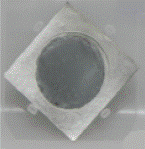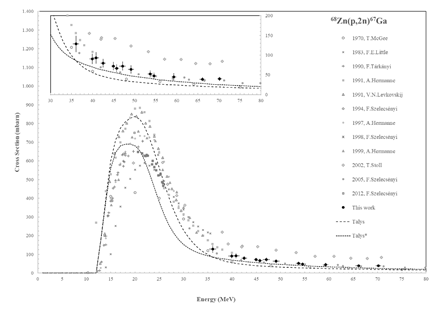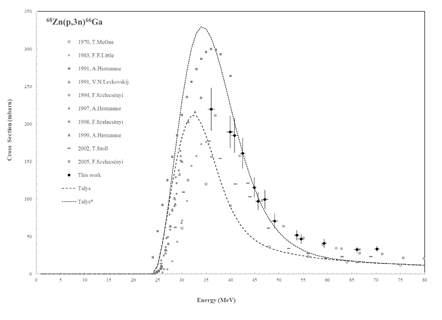INTRODUCTION
Theranostics is a new treatment strategy that combines therapy and diagnostics, allowing the possibility to select patients that have a good chance to respond to the specific radiopharmaceutical. Among the theranostic isotopesof major interest [1], 67Cu is probably the most promising candidate due to the specific role of copper in several biochemical processes. In addition, 67Cu has been long considered an excellent nuclide for radioimmuno-therapy (RIT), by means of its peculiar physical-chemical characteristics (Table 1). Its relatively long half-life (61.83 h) permits to follow the slow biodistribution of antibodies, the most used bioactive vectors for 67Cu, while its β-emission (mean Eβ- = 141 keV) has a therapeutic effect of short-medium range on the targeted cells. The low energy γ-rays produced by67Cu decay (Eγ = 184.58 keV, 48.6%) [2] allow to follow its uptake, by using standard SPECT or SPECT/CTcameras developed for the 140 keV γ-rays of 99mTc. In recent years the main limiting factor for a more consistent evaluation of 67Cu in clinical trials was its availability. In the framework of the LARAMED (LAboratory of RAdionuclides for MEDicine) [3] project , a collaboration between the ARRONAX facility (Acceleration for Research in Radiochemistry and Oncology at Nantes Atlantique) [4] and INFN-LNL (Istituto Nazionale di Fisica Nucleare, Laboratori Nazionali di Legnaro) started, aimed at investigating the best production routes, based on high-performance cyclotrons,of radionuclides with relevant medical interest, including 67Cu.The accurate knowledge of the cross section is the first step towards the optimization of radioisotope production: acritical analysis of previous data available on EXFOR library [5] showed that there are some discrepancies. In fact, during the proton irradiation of 68Zn target there is the co-production of large quantity of67Ga (half-life 3.2617 d), that as 67Cu decays to the stable daughter nuclei 67Zn. In addition to the similar half-lives, respectively about 62 and 78 hours, 67Cu and 67Ga present the same γ-rays emission with different relative intensities (Table 1). This fact requested a radiochemical process before γ-spectroscopy measurements to efficiently separate Cu from Ga isotopes and get accurate measurements of their activity values.The separation procedure could be a possible source of discrepancy between authors, as well as the use of different target materials (natural versus enriched), manufacturing techniques and selected monitor reactions or not up-to-date decay data.The purpose of this work was to provide a new accurate measurement of the 68Zn(p,2p)67Cu excitation function in the energy range 35-70 MeV. Highly enriched 68Zn materialwas used and the yield of the chemical process was monitored for each irradiated target.61Cu and 66Ga radionuclides were used as tracer isotopes of the separation procedure, respectively for copper and gallium elements, thanks to their characteristics γ-rays and suitable half-lives (Table 1). New data of the 68Zn(p,2n)67Ga and 68Zn(p,3n)66Ga cross sections were also obtained.
Considering the increasing interest of 67Cu in theranostics and the recent availability of compact cyclotrons, the thick target yield for 70 MeV proton beams and fully enriched 68Zn targets was calculated.
Table 1 Nuclear data associated to the radionuclides of interest, extracted from the NuDat2 Database (National Nuclear Data Center, NNDC) [7]
| Radionuclide | Half-life | Eγ (keV) | Iγ (%) |
|---|---|---|---|
| 67Cu | 61.83 h (12) |
184.577 (10) 208.951 (10) 300.219 (10) 393.529 (10) |
48.7 (3) 0.115 (5) 0.797 (11) 0.220 (8) |
| 64Cu | 12.701 h (2) | 1345.77 (6) | 0.475 (11) |
| 61Cu | 3.333 h (5) |
282.956 (10) 656.008 (10) |
12.2 (22) 10.8 (20) |
| 67Ga | 3.2617 d (5) |
184.576 (10) 208.950(10) 300.217(10) 393.527(10) |
21.410 (10) 2.460 (10) 16.64 (12) 4.56 (24) |
| 66Ga | 9.49 h (3) | 1039.220 (3) | 37.0 (20) |
| 57Ni | 35.60 h (6) |
127.167 (3) 1377.63 (3) |
16.7 (5) 81.7 (24) |
| 22Na | 2.6027 y (10) | 1274.537 (7) | 99.941 (14) |
MATERIALS AND METHODS
The irradiation runs were performed at the ARRONAX facility in the energy range 35-70 MeV, using the stacked-foils technique, obtaining several experimental data on each run through the simultaneous bombardment of a set of thin foils. A typical stacked-foils target was made by two identical patterns composed by an enriched 68Zn target foil and a monitor foil, used to measure the effective beam flux by considering a reference reaction recommended by IAEA [6]. Some aluminium foils (500 μm-1 mm thick) were used to separate the two patterns, decrease the proton beam energy and catch possible recoil atoms. Considering that 61Cu was not produced into 68Zn targets in case of low energy proton beams (threshold energy ETHR=35.97 MeV), a natural copper foil (20 μm thick) was added to the stacked-target and later used in the chemical process as source of 61Cuviathe natCu(p,x) reaction. On the contrary 66Ga, the tracer radionuclide of gallium isotopes, was always directly produced into 68Zn targets in the energy range investigated (ETHR=23.55 MeV).Stacked-foils targets were made using high purity foils (>99%, Goodfellow Cambridge Ltd., UK). The 68Zn target foils were obtained by electrodeposition of enriched 68Zn metallic powder purchased by CHEMGAS (Boulogne-Billancourt, France) with isotopic composition 64Zn (0.18%), 66Zn (0.13%), 67Zn (0.55%),68Zn (98.78%), 70Zn (0.36%); a natural high-purity silver foil (25 µm thick) was used as support (Figure 1).
Electroplated target foils were inserted into the stacked-target and irradiated by the proton beam provided by the ARRONAX cyclotron with energy ranging from 35 MeV to 70 MeV. A typical irradiation run had a duration of 1.5 hours with a constant current of about 100-230 nA, monitored during the bombardment by using an instrumented beam dump. After 14 hours of cooling time, a radiochemical procedure was applied to irradiated targets in order to separate gallium from copper isotopes. This procedure was based on a Cu-resin (purchased to TrisKem International, France) able to selectively retain and release copper atoms under specific conditions. Further details of the radiochemical procedure can be found in [7]. The yield of chemical processing was monitored for all target foils, by measuring the activities of the tracer radionuclides, before and after the radiochemical procedure. All samples were measured with the same high-purity germanium (HPGe) detector (10% relative efficiency, FWHM 1.0 keV at 122 keV, Canberra GC1020), previously calibrated with standard liquid source.Two sample-detector positions (at 19 cm distance and at contact) were used to always keep the dead time below 10%.The well-known activation formula was used to calculate the cross section values, by considering the monitor reactions natNi(p,x)57Ni and natAl(p,x)22Na recommended by IAEA [6], respectively for energies lower and higher than 50 MeV.The isotopic purity of the 68Zn deposit and the chemical purity of reference foils were taken into account in the cross section calculation; results of the 68Zn(p,2p)67Cu, 68Zn(p,2n)67Ga and 68Zn(p,3n)66Ga reactions referred to 100% enriched 68Zn target. The uncertainty of the cross section values were evaluated in a quadratic form, considering individual uncertainties: reference cross section (≤ 10%), measured activity (≤ 8%), target thickess and decay data values (1%).
RESULTS
The radiochemical yield for copper and gallium isotopes was precisely determined by using the tracer radionuclide activities (61Cu and 66Ga). The efficiency of the separation procedure was calculated measuring the presence of 61Cu (and thus copper isotopes) into the gallium solution and viceversa. It was found thatthe 66Ga activity (and thus 67Ga activity) into the copper solution was about 0.2% of its initial activity (i.e.before the chemical process), while 61Cu activity (and thus 67Cu) into the gallium solution was always below the Minimum Detectable Activity (MDA), corresponding to less than 1% of 61Cu initial activity.These results showed a high yield of separation Cu/Ga isotopes, assuring a proper measurement of 67Cu and 67Ga activity values.
Figure 2, Figure 3 and Figure 4 reported the results obtained in this work respectively for the 68Zn(p,2p)67Cu, 68Zn(p,2n)67Ga and 68Zn(p,3n)66Ga nuclear reactions.Literature data available from EXFOR database [5] were reported on figures without error bars for clarity; TALYS estimations, obtained by using both default (Talys) and new set of models (Talys*) [7,8], were also shown as dashed and dotted lines (Figure 2-4).
Figure 2 reported the 68Zn(p,2p)67Cu cross section measured in this work in the energy range 35-70 MeV, compared with literature [5] and TALYS estimations. The new set of data obtained in this work was in good agreement with previous measurements, in particular with the latest ones. Szelecsényi et al. (2009) measured the cross section from the threshold energy up to 40 MeV, describing the rising region of the nuclear reaction. Bonardi et al. (2005) irradiated a natural zinc target: their data in Figure 2 were rescaled to a 100% enriched 68Zn material, thus including the additional contribution of (p,x) reactions on 70Zn (0.61% natural abundance). Stoll et al. (2002) investigated the energy range 25-71 MeV, obtaining two series of values in the energy range 35-45 MeV. It has to be noted that data obtained by Levkovskij et al. (1991) were rescaled by an appropriate factor to correct the use of an over-estimated reference reaction, as reported in EXFOR database [5]. Previous data were considered not reliable, due to the large discrepancy with other authors; in particular, results by McGee et al. (1970) did not reproduce the expected shape of the excitation function even after the adjustment needed to account for up-to-date IAEA monitor data.
Figure 3 showed the measurements of the 68Zn(p,2n)67Ga cross sections obtained in this work, also reporting literature data and estimations performed with TALYS software and the two set of models. The 68Zn(p,2n)67Ga nuclear reaction has an intense peak value (about 700 mbarn) at energies lower than 25 MeV (Figure 3). Data measured in this work described the decreasing part of the reaction: there is an excellent agreement with values obtained by Szelecsényi et al. (2005) in the entire energy range (35-70 MeV) and, in the energy region 35-45 MeV, with data by Hermanne et al. (1991). The same author repeated the measurement up to 33 MeV, confirming previous results. The only discrepancy at high energy was the data set by Stoll et al. (2002), that seemed to almost double the cross section values in the entire energy range (38-71 MeV).
Figure 4 reported the measurements of the 68Zn(p,3n)66Ga cross section: as in case of 67Ga, results obtained in this work described the decreasing part of the nuclear reaction. There was an excellent agreement with latest values by Szelecsényi et al. (2005) in the entire energy range (35-70 MeV).Measurements by Stoll et al. (2002) were in good agreement for energies higher than 43 MeV, while at lower energies these previous data seemed to underestimate the nuclear reaction. Hermanne et al. (1991) measured a very high peak value (around 290 mb at 34 MeV), but the same authors repeated the experiment in 1999 and these later data are in good agreement with results obtained in this work.
DISCUSSION
Considering the recent availability of compact cyclotrons, able to provide intense proton beams of high energy, the production yield of 67Cu was also calculated. The yield value of 67Cu in the energy range 70-35 MeV, based on the experimental data of the 68Zn(p,2p)67Cu cross section obtained in this work, is 24.25 MBq/µAh.This value is 15% lower than the IAEA estimation in the same energy region (28.46 MBq/µAh) [9]. In order to maximize the production of the radionuclide of interest it is possible to extend the calculation to a larger energy range. In view of the good agreement of our data for the 68Zn(p,2p)67Cu cross section with the results obtained by using TALYS code with the set of models proposed by [8], it is possible to extend the yield calculation in the energy range 70-19 MeV, i.e. the starting energy of the nuclear reaction of interest.This thick target yield value is 25.95 MBq/µAh, i.e.the increase is 7% in respect of the yield in the energy range 70-35 MeV. On the other hand the increase of the thickness of the target material needed is around 28%. Considering the cost of the enriched material and the final use of 67Cu radionuclide (i.e. contaminant co-production), the best energy range should be carefully evaluated, taking into account also the target design and its cooling system.
CONCLUSION
In this work the new cross section data of the 68Zn(p,x)67Cu, 67Ga, 66Ga reactions were presented. Experiments were performed at the ARRONAX facility by using 70 MeV proton cyclotron, enriched 68Zn and applying a simple chemical procedure to accurately measure 67Cu and 67Ga activity values by γ-spectrometry. The separation yield was determined during each separation process by using 61Cu and 66Ga radionuclides as tracer isotopes, respectively for copper and gallium elements. Reference reactions proposed by IAEA were used to monitor beam flux and calculate the cross sections. The new set of data obtained in this work for all the radionuclides of interest were in good agreement with the latest measurements. The TALYS software was used to estimate the nuclear reaction of interest: in case of the 68Zn(p,2n)67Cu the new set of models suitably described data obtained in this work but TALYS predictions of the (p,2n) and (p,3n) reactions presented some discrepancies with experimental values in the peak energy region; this fact highlighted the need of further work on nuclear models for specific reactions and energy range of interest.
Based on the data obtained in this work the yield of 67Cu was calculated for thick targets and it was found to be 15% lower than the IAEA estimation in the same energy region (70-35 MeV); this difference is relevant in order to plan a sustainable production of67Cu for medical purpose. Specific evaluations about the optimal irradiation conditions, taking into account the cost of enriched target material and the specific final use of 67Cu-labelled radiopharmaceuticals, are recommended. In order to plan a sustainable production of 67Cu for preclinical and clinical use it is important also to consider the recovery and reuse of irradiated material through definite radiochemical procedures.


















